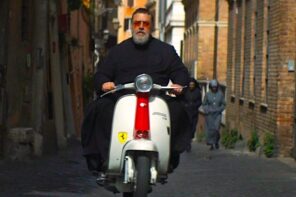Pope Benedict XVI named 24 new cardinals, including two Americans, at the end of yesterday’s weekly Wednesday audience: Archbishop Donald W. Wuerl of Washington DC and Raymond L. Burke, formerly of St. Louis, and now Prefect of the Apostolic Signatura, the Supreme Court of the Vatican. They are among 20 of the 24 who are young enough—i.e. under 80—to vote for the next Pope.
In a radio interview on the day of the announcement Cardinal-designate Donald Wuerl was asked what one has to do to become a cardinal. He finessed the question by saying, with humility that would choke a horse, that the honor was really for the city of Washington DC, the nation’s capital, and not so much for him personally. Since the rest of us in DC won’t actually have any cause to run out and pick up a new red hat, I would have preferred that he answer the question honestly. The honest answer, to all appearances, is that to become a cardinal you have to do in at least one fellow Catholic. I realize that sounds more like gaining membership in a gang or the mob than being named to a high-ranking religious post, but it’s the most apt analogy I can find for how the Roman Catholic system seems to work.
Cardinal-Designate Donald Wuerl
For all the good Wuerl may have done in his lifetime, it is hard to forget at this time when his power in the Roman Catholic Church has just increased geometrically (he will be one of the 120 or so electors of the next Pope) how he earned his spurs. Ordained in 1966 for the Diocese of Pittsburgh, his lack of significant parish experience didn’t prevent him from being named secretary to the local bishop, John Wright. As secretary, he followed Wright to Rome when Wright became a cardinal and was appointed as the Prefect of the Congregation for the Clergy. When Wright died, Wuerl went back to his home diocese in Pittsburgh to head the local seminary in 1982. But by 1985 he was destined for a higher calling.
Meanwhile, Archbishop Raymond Hunthausen of Seattle was a popular and liberal cleric who ran afoul of Joseph Cardinal Ratzinger, then head of the Congregation for the Doctrine of the Faith. Much like the US nuns who are being investigated now, Hunthausen was the subject of an Apostolic Visitation because he was supportive of civil and religious rights for women and LGBTQ people. The result was that Wuerl was named as his auxiliary bishop with final decision-making power over liturgy, ministry to LGBTQ people, and health care—areas that Archbishop Hunthausen was seen by the Vatican to be soft on. This was a most unusual arrangement, simply not done in a system where each bishop handles his own geographic area. It was an obvious affront to Hunthausen; a kind of ecclesial punishment.
Outcry from people in the Archdiocese of Seattle, including clergy and religious, was so fierce that the Vatican eventually backed down and sent Wuerl packing to Pittsburgh a short time later. But the damage was done. Hunthausen had been insulted and his power usurped. Wuerl was the one who did the Vatican’s bidding. The red hat took some years, but now he’s got it, ostensibly as a reward for showing loyalty at Hunthausen’s expense.
Cardinal Anthony Bevilaqua
Vacating the top spot in Pittsburgh to make room for Wuerl was Archbishop Anthony Bevilaqua who went on to become a cardinal in Philadelphia. Similarly, he got his red hat by delivering papers on behalf of Rome to Mercy Sister Agnes Mary Mansour. After a failed run for Congress, Agnes Mary Mansour was named head of the Department of Social Services in the State of Michigan through which office funds for abortions were channeled. Detroit’s Cardinal Edmund Szoka ordered her to leave her post, but she resisted with support from her Mercy community. She argued that even though she was personally opposed to abortion she was bound by her job description to do the work the people of Michigan hired her to do.
Bevilaqua, an expert in canon law, was allegedly deputized personally by Pope John Paul II to deliver her two sets of papers—either she resign her job or leave the Sisters of Mercy. It is a murky tale of Vatican shenanigans carried on behind the backs of the Sisters of Mercy who had received personal assurances from a high-ranking Vatican official that nothing untoward would happen while their leader was out of the country. The nuns learned whom not to trust. But Bevilaqua did the Pope’s bidding and was rewarded with his red hat in Philadelphia a few years later.
Cardinal-Designate Raymond Burke
Raymond Burke’s track to the red hat includes a similar incident. When he wasn’t busy condemning President Obama and other pro-choice politicians, including the late Senator Edward Kennedy to whom he would have denied a Catholic funeral, he was condemning progressive nuns. But perhaps it was the case of Sister of Charity Louise Lears that gave him the boost he needed.
Louise Lears, who has a PhD in medical ethics, served on the pastoral team of Saint Cronan Parish and was an adjunct professor at St. Louis University. Her support for, and presence at, the ordination of two members of the Roman Catholic Women Priests group in 2007 that got Burke’s Irish up. The ceremony was held not in the local cathedral but in a synagogue whose rabbi was a strong supporter of her sisters’ ministry.
Archbishop Burke, with scant attention to dialogue and little regard for her well-being, placed Louise Lears under interdict, prohibiting her from working in diocesan venues or receiving the Catholic sacraments. In fact, he issued the decree the day before he left St. Louis for greener pastures in Rome. He now heads the court that would be one of the few ecclesial venues for appealing Sister Lears’ case. So much for due process.
There is much more to say about the two new American cardinals as they join an increasingly conservative group who will advise the pope and select his successor. This latest crop includes more Italian cardinals than those from developing countries even though the so-called “Third World” is where Catholicism is growing. Things change slowly if at all in Rome. But the not-so-coincidental similarities in the cardinals’ respective paths to the red hats, eventually to the conclave, and perhaps even to the papacy itself, make for a cautionary tale well worth the listen.




